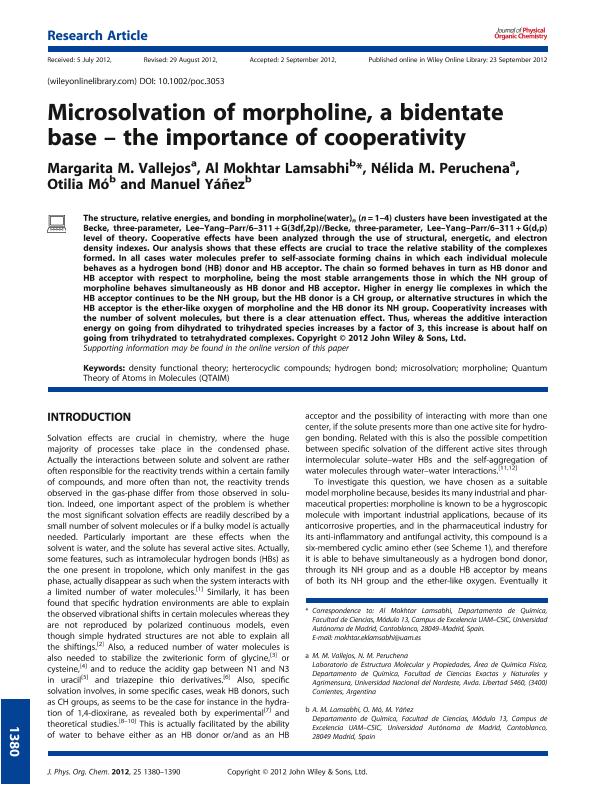Mostrar el registro sencillo del ítem
dc.contributor.author
Vallejos, Margarita

dc.contributor.author
Lamsabhi, Al Mokhtar
dc.contributor.author
Peruchena, Nelida Maria

dc.contributor.author
Mó, Otilia
dc.contributor.author
Yáñes, Manuel
dc.date.available
2020-06-02T15:12:31Z
dc.date.issued
2012-12
dc.identifier.citation
Vallejos, Margarita; Lamsabhi, Al Mokhtar; Peruchena, Nelida Maria; Mó, Otilia; Yáñes, Manuel; Microsolvation of morpholine, a bidentate base: the importance of cooperativity; John Wiley & Sons Ltd; Journal Of Physical Organic Chemistry; 25; 12; 12-2012; 1380-1390
dc.identifier.issn
0894-3230
dc.identifier.uri
http://hdl.handle.net/11336/106473
dc.description.abstract
The structure, relative energies and bonding in morpholine(water)n (n = 1-4) clusters have beeninvestigated at the B3LYP/6-311+G(3df,2p)//B3LYP/6-311+G(d,p) level of theory. Cooperative effects have been analyzed through the use of structural, energetic and electron density indexes. Our analysis shows that these effects are crucial to trace the relative stability of the complexes formed. In all cases water molecules prefer to self-associate forming chains in which each individual molecule behaves as a HB donor and HB acceptor. The chain so formed behaves in turn as HB donor and HB acceptor with respect to morpholine, being the most stable arrangements those in which the NH group of morpholine behaves simultaneously as HB donor and HB acceptor. Higher in energy lie complexes in which the HB acceptor continues to be the NH group, but the HB donor is a CH group, or alternative structures in which the HB acceptor is the ether-like oxygen of morpholine and the HB donor its NH group. Cooperativity increases with the number of solvent molecules, but there is a clear attenuation effect. Thus, whereas the additive interaction energy on going from dihydrated to trihydrated species increases by a factor of 3, this increase is about half on going from trihydrated to tetrahydrated complexes.
dc.format
application/pdf
dc.language.iso
eng
dc.publisher
John Wiley & Sons Ltd

dc.rights
info:eu-repo/semantics/openAccess
dc.rights.uri
https://creativecommons.org/licenses/by-nc-sa/2.5/ar/
dc.subject
DENSITY FUNCTIONAL THEORY
dc.subject
HERTEROCYCLIC COMPOUNDS
dc.subject
HYDROGEN BOND
dc.subject
MICROSOLVATION
dc.subject
QUANTUM THEORY OF ATOMS IN MOLECULES (QTAIM)
dc.subject.classification
Otras Ciencias Químicas

dc.subject.classification
Ciencias Químicas

dc.subject.classification
CIENCIAS NATURALES Y EXACTAS

dc.title
Microsolvation of morpholine, a bidentate base: the importance of cooperativity
dc.type
info:eu-repo/semantics/article
dc.type
info:ar-repo/semantics/artículo
dc.type
info:eu-repo/semantics/publishedVersion
dc.date.updated
2020-04-23T21:41:55Z
dc.journal.volume
25
dc.journal.number
12
dc.journal.pagination
1380-1390
dc.journal.pais
Reino Unido

dc.journal.ciudad
Londres
dc.description.fil
Fil: Vallejos, Margarita. Consejo Nacional de Investigaciones Científicas y Técnicas. Centro Científico Tecnológico Conicet - Rosario. Instituto de Química Rosario. Universidad Nacional de Rosario. Facultad de Ciencias Bioquímicas y Farmacéuticas. Instituto de Química Rosario; Argentina
dc.description.fil
Fil: Lamsabhi, Al Mokhtar. Universidad Autónoma de Madrid. Facultad de Ciencias; España
dc.description.fil
Fil: Peruchena, Nelida Maria. Consejo Nacional de Investigaciones Científicas y Técnicas; Argentina
dc.description.fil
Fil: Mó, Otilia. Universidad Autónoma de Madrid. Facultad de Ciencias; España
dc.description.fil
Fil: Yáñes, Manuel. Universidad Autónoma de Madrid. Facultad de Ciencias.Departamento de Química; España
dc.journal.title
Journal Of Physical Organic Chemistry

dc.relation.alternativeid
info:eu-repo/semantics/altIdentifier/url/https://onlinelibrary.wiley.com/doi/abs/10.1002/poc.3053
dc.relation.alternativeid
info:eu-repo/semantics/altIdentifier/doi/https://doi.org/10.1002/poc.3053
Archivos asociados
